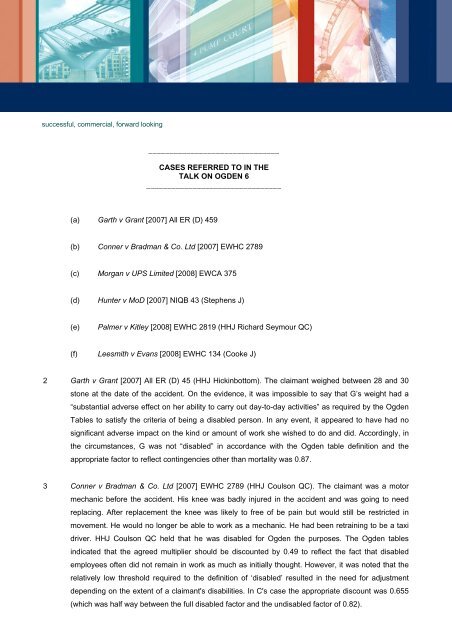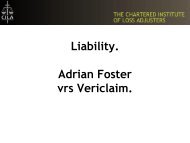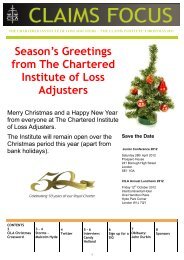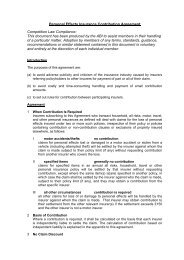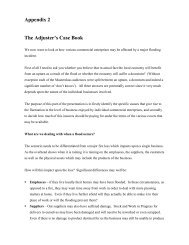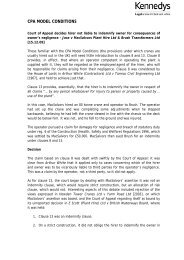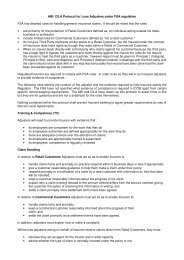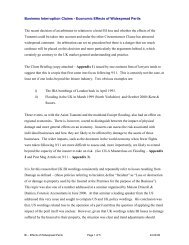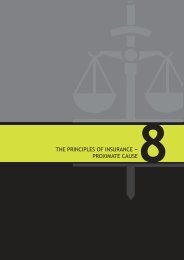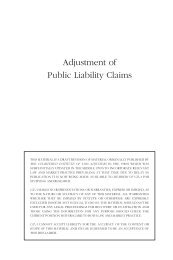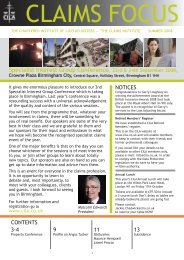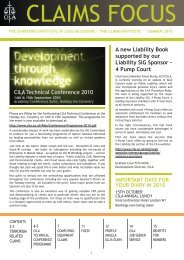Cases referred to in.. - CILA/The Chartered Institute of Loss Adjusters
Cases referred to in.. - CILA/The Chartered Institute of Loss Adjusters
Cases referred to in.. - CILA/The Chartered Institute of Loss Adjusters
- No tags were found...
You also want an ePaper? Increase the reach of your titles
YUMPU automatically turns print PDFs into web optimized ePapers that Google loves.
successful, commercial, forward look<strong>in</strong>g_______________________________CASES REFERRED TO IN THETALK ON OGDEN 6________________________________(a) Garth v Grant [2007] All ER (D) 459(b) Conner v Bradman & Co. Ltd [2007] EWHC 2789(c) Morgan v UPS Limited [2008] EWCA 375(d) Hunter v MoD [2007] NIQB 43 (Stephens J)(e)Palmer v Kitley [2008] EWHC 2819 (HHJ Richard Seymour QC)(f) Leesmith v Evans [2008] EWHC 134 (Cooke J)2 Garth v Grant [2007] All ER (D) 45 (HHJ Hick<strong>in</strong>bot<strong>to</strong>m). <strong>The</strong> claimant weighed between 28 and 30s<strong>to</strong>ne at the date <strong>of</strong> the accident. On the evidence, it was impossible <strong>to</strong> say that G’s weight had a“substantial adverse effect on her ability <strong>to</strong> carry out day-<strong>to</strong>-day activities” as required by the OgdenTables <strong>to</strong> satisfy the criteria <strong>of</strong> be<strong>in</strong>g a disabled person. In any event, it appeared <strong>to</strong> have had nosignificant adverse impact on the k<strong>in</strong>d or amount <strong>of</strong> work she wished <strong>to</strong> do and did. Accord<strong>in</strong>gly, <strong>in</strong>the circumstances, G was not “disabled” <strong>in</strong> accordance with the Ogden table def<strong>in</strong>ition and theappropriate fac<strong>to</strong>r <strong>to</strong> reflect cont<strong>in</strong>gencies other than mortality was 0.87.3 Conner v Bradman & Co. Ltd [2007] EWHC 2789 (HHJ Coulson QC). <strong>The</strong> claimant was a mo<strong>to</strong>rmechanic before the accident. His knee was badly <strong>in</strong>jured <strong>in</strong> the accident and was go<strong>in</strong>g <strong>to</strong> needreplac<strong>in</strong>g. After replacement the knee was likely <strong>to</strong> free <strong>of</strong> be pa<strong>in</strong> but would still be restricted <strong>in</strong>movement. He would no longer be able <strong>to</strong> work as a mechanic. He had been retra<strong>in</strong><strong>in</strong>g <strong>to</strong> be a taxidriver. HHJ Coulson QC held that he was disabled for Ogden the purposes. <strong>The</strong> Ogden tables<strong>in</strong>dicated that the agreed multiplier should be discounted by 0.49 <strong>to</strong> reflect the fact that disabledemployees <strong>of</strong>ten did not rema<strong>in</strong> <strong>in</strong> work as much as <strong>in</strong>itially thought. However, it was noted that therelatively low threshold required <strong>to</strong> the def<strong>in</strong>ition <strong>of</strong> ‘disabled’ resulted <strong>in</strong> the need for adjustmentdepend<strong>in</strong>g on the extent <strong>of</strong> a claimant's disabilities. In C's case the appropriate discount was 0.655(which was half way between the full disabled fac<strong>to</strong>r and the undisabled fac<strong>to</strong>r <strong>of</strong> 0.82).
4 Morgan v UPS Limited [2008] EWCA 375 Smith v Manchester award arrived at somewhat irrationallybut nevertheless upheld by CoA.5 Hunter v MoD [2007] NIQB 43 (Stephens J). Everyth<strong>in</strong>g had been agreed apart from the claimant’sresidual earn<strong>in</strong>g capacity. <strong>The</strong> multiplicand for this also appears <strong>to</strong> have been broadly agreed at£15,311 (§12) which the judge adjusted down <strong>to</strong> £15K (§17). Thus the Judge was concerned solelywith the multiplier. <strong>The</strong> claimant was 36, out <strong>of</strong> work, disabled, and <strong>of</strong> education standard O. Table Bgave a discount fac<strong>to</strong>r <strong>of</strong> 0.20 which the judge spoke <strong>of</strong> as a discount <strong>of</strong> 80%. <strong>The</strong> judge found thatby the time <strong>of</strong> trial the claimant ought <strong>to</strong> have found a job. This would have produced a fac<strong>to</strong>r <strong>of</strong> 0.39i.e. a discount <strong>of</strong> 61%. If he had been unemployed but not disabled the fac<strong>to</strong>r would have been 0.80i.e. a discount <strong>of</strong> 20%. After a review <strong>of</strong> the medical evidence the judge plumped for a discount <strong>of</strong>40%.6 Palmer v Kitley [2008] EWHC 2819 (HHJ Richard Seymour QC) “It was obvious, <strong>in</strong> my judgment,that the calculation <strong>of</strong> the claim for future loss <strong>of</strong> earn<strong>in</strong>gs was extremely sensitive <strong>to</strong> theassumptions fed <strong>in</strong><strong>to</strong> it.” After a very detailed analysis he applied Blamire v South Cumbria HA[1993] PIQR Q1 CA and awarded £30K for loss <strong>of</strong> earn<strong>in</strong>g capacity.7 Leesmith v Evans [2008] EWHC 134 (Cooke J) C, aged 28 at trial, was a light<strong>in</strong>g technician whosuffered a knee <strong>in</strong>jury requir<strong>in</strong>g an above-knee amputation, as well as <strong>in</strong>jury <strong>to</strong> his dom<strong>in</strong>ant hand.He returned <strong>to</strong> work as a light<strong>in</strong>g technician but <strong>in</strong> a limited capacity, result<strong>in</strong>g <strong>in</strong> lower pay. Towardsthe end <strong>of</strong> his judgment Cooke J said:From this figure falls <strong>to</strong> be subtracted the agreed net earn<strong>in</strong>gs, which it is acceptedthat the claimant will earn <strong>to</strong> age 65, <strong>of</strong> £10,000 per annum. Prima facie, themultiplier <strong>to</strong> be applied here is 23.4 but if the adjustment required by table B which is0.54 is used, the result<strong>in</strong>g figure is 12.64 as the appropriate multiplier. <strong>The</strong>defendant however submits that the degree <strong>of</strong> disability must be taken <strong>in</strong><strong>to</strong> account.It is contended that the fac<strong>to</strong>r <strong>to</strong> be applied <strong>to</strong> the multiplier should not be the fac<strong>to</strong>r<strong>of</strong> 0.54 but should be someth<strong>in</strong>g between the 0.92 fac<strong>to</strong>r from table A, for fully ablemales, and the 0.54 fac<strong>to</strong>r, for disabled males, because <strong>of</strong> the wide def<strong>in</strong>ition <strong>of</strong>“disabled” at paragraph 35 at page 60 <strong>of</strong> “Facts and Figures”. <strong>The</strong> defendant po<strong>in</strong>tsout that the figure <strong>of</strong> £10,000 net fully takes <strong>in</strong><strong>to</strong> account the degree <strong>of</strong> disability <strong>of</strong>the claimant and submits that <strong>to</strong> adopt the full fac<strong>to</strong>r here would be unjust. With thatsubmission I only partly agree and do not feel able <strong>to</strong> adjust that fac<strong>to</strong>r by much.<strong>The</strong> fac<strong>to</strong>r I apply is 0.6.Oliver Ticciatioticciati@4pumpcourt.com31 March 2009Chief Executive Carolyn McCombe Senior Clerks Carl Wall and Stewart Gibbs4 Pump Court, Temple, London EC4Y 7ANTel +44 (0)20 7842 5555 Fax +44 (0)20 7583 2036 DX 303 LDE Web www.4pumpcourt.com


